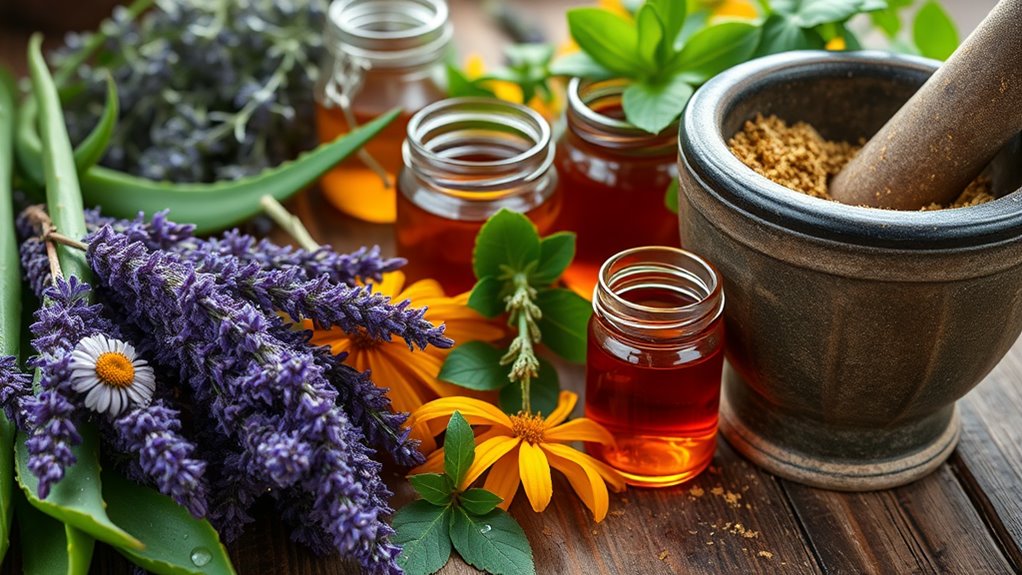The Herbs I Use to Make My Own Skin-Healing Balm at Home
Calendula: The Skin Soother
When you’re looking for a natural way to soothe skin irritations, calendula is your go-to herb. This vibrant flower possesses powerful anti-inflammatory properties that can calm redness and irritation. Additionally, using an herbal-infused oil can enhance your skin’s overall health and promote radiant skin. To create an effective herbal balm recipe, infuse calendula flowers in olive oil, then blend with beeswax. You’ll have a nourishing balm that promotes healing and provides comfort to your skin.
Comfrey: Nature’s Healing Power
Comfrey is packed with active compounds that promote skin healing, making it a powerful ingredient in your balm.
When using comfrey, it’s key to follow recommended guidelines to ensure safety and effectiveness.
Understanding its properties will help you harness nature’s healing power for your skin.
Comfrey’s Active Compounds
While many herbs boast healing properties, few can rival comfrey’s remarkable ability to promote skin repair.
Its active compounds, particularly allantoin, stimulate cell regeneration and soothe inflammation. You’ll also find tannins, which provide astringent qualities, helping to tighten and heal the skin.
With these potent ingredients, comfrey works wonders, making it an essential addition to your skin-healing balm recipe.
Recommended Usage Guidelines
To maximize the benefits of comfrey in your skin-healing balm, follow specific guidelines for safe and effective use.
Limit application to small areas, and avoid using it on broken skin. Use comfrey-infused oil in moderation, ideally mixing with other soothing ingredients.
Lavender: The Calming Herb
When you think of lavender, the first thing that often comes to mind is its soothing aroma.
This calming herb not only enhances your mood through aromatherapy but also boasts impressive skin-soothing properties. Additionally, lavender oil is known for its calming properties, making it a perfect ingredient to include in your skin-healing balm.
In the following sections, you’ll discover easy DIY recipes that harness lavender’s benefits for your skin-healing balm.
Aromatherapy Benefits Explained
Lavender, known for its soothing aroma, offers more than just a pleasant scent; it’s a powerful ally in aromatherapy.
You’ll find these benefits particularly impactful:
- Reduces stress and anxiety.
- Promotes restful sleep.
- Enhances mood and mental clarity.
- Boosts overall well-being.
Incorporating lavender into your routines can significantly improve your emotional health and create a calming environment.
Skin Soothing Properties
The calming properties of lavender extend beyond the realm of aroma into skin care, making it a go-to ingredient for those seeking natural relief for various skin issues.
Lavender’s anti-inflammatory and antimicrobial qualities help soothe irritated skin and promote healing. Its gentle scent also reduces stress, creating a holistic approach to skin health and wellness, perfect for enhancing your homemade balm.
Easy DIY Recipes
If you’re looking to harness the soothing powers of lavender in your skincare routine, creating your own healing balm is both simple and rewarding.
Here’s what you’ll need:
- 1/4 cup coconut oil
- 2 tablespoons beeswax
- 10 drops of lavender essential oil
- 1 teaspoon vitamin E oil
Melt the oils, combine, pour into a container, and let it set.
Enjoy softer, calmer skin!
Chamomile: The Gentle Healer
Chamomile is often hailed as a gentle healer, renowned for its soothing properties that can significantly benefit skin care.
This herb calms irritated skin, reduces redness, and promotes healing. You can easily infuse dried chamomile flowers into your balm, enhancing its efficacy. Incorporating chamomile into your routine not only nurtures your skin but also provides a delightful, calming aroma during application. Additionally, its benefits extend to improving sleep quality, making it a multi-functional addition to your wellness arsenal.
Rosemary: The Antiseptic Aid
While you might be familiar with rosemary as a culinary herb, this potent plant also serves as a powerful antiseptic for your skin.
Its benefits include:
- Healing minor cuts and scrapes
- Reducing inflammation and redness
- Preventing infection with its antimicrobial properties
- Promoting faster skin regeneration
Incorporating rosemary into your balm maximizes healing effects, ensuring your skin stays clean and healthy. Additionally, the use of sound healing practices can enhance the overall wellness experience, promoting a holistic approach to skin care and healing.
Essential Oils: Adding Aroma and Benefits
In addition to the healing properties of rosemary, incorporating essential oils into your skin-healing balm can enhance both its aroma and therapeutic benefits.
Oils like lavender soothe irritation, while tea tree oil adds extra antibacterial properties. Just a few drops can transform your balm, making it a fragrant, healing treat for your skin. Incorporating lavender essential oil into your routine can elevate your self-care practices by providing calming effects.
Experiment with blends to find what resonates with you!

